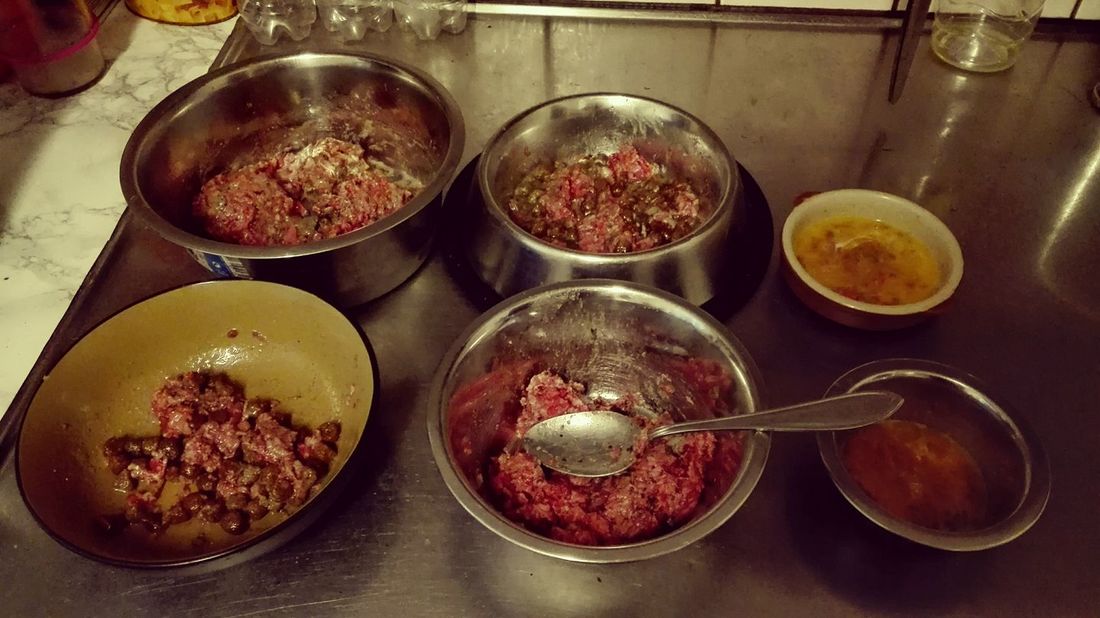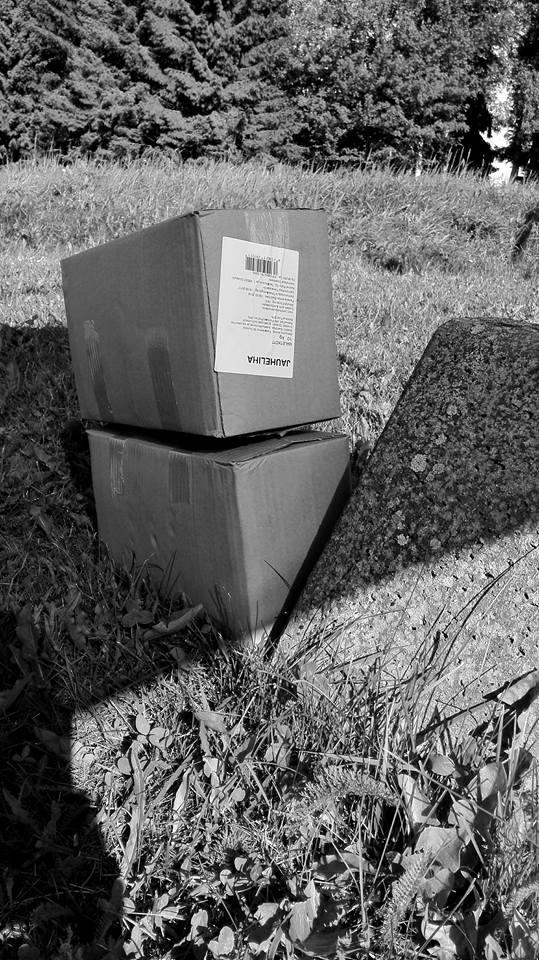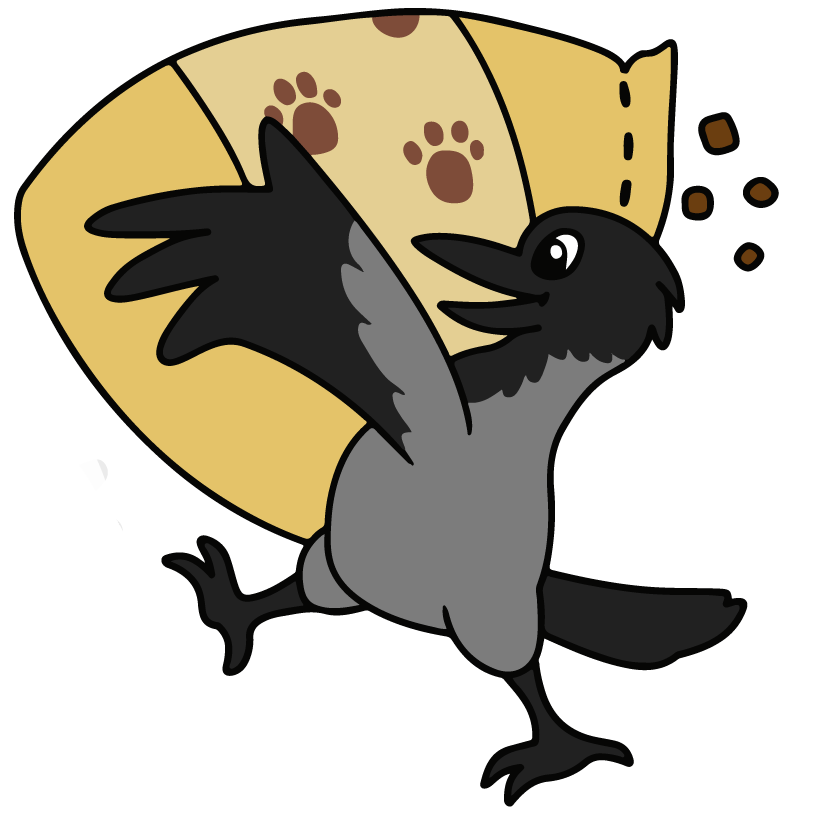And from a dummie, might I add. I am not seeing myself as any kind of an expert here, but I am good at researching and understanding written instructions. Based on those I have re-evaluated my feeding and found out some mistakes I have been making. I thought I'd share some of what I have read with you now, so you could avoid my errors.I have talked about feeding raw meat before, so if you want to, you might like to check out my previous post. Before we start, I want to underline once more I am just a dog enthusiast and someone who fights to feed my dogs the very best I can. None of what I write here is to be considered an ultimate truth. I base my feeding mainly to the teachings of two dog feeding instructors. In some things they agree, in some they disagree. I am not really swearing for either's name, I just try to pick up what I can and make my own assumptions. Basically when raw feeding a dog you must make sure you are giving your dog every vitamin and mineral it needs as well as the right kind of meat it can consume and use. Now, some people believe all this can be achieved with natural ingredients, while some people believe you can never get enough from the food itself. I am somewhere in the middle. I think it is possible to get everything you need from natural sources, but that situation might be easier to accomplish with some well chosen ad-ons. I am NOT one of those who think it's best to give lots of extra. I believe filling the need is a must, some extra to that doesn't do harm, but giving double doses based on limited internet sources or personal thoughts is most likely not justified. VitaminsAt this point I am using the chart offered by Katiska (https://www.katiska.info/ruokinta/yleista/vitamiinit-ja-hivenaineet-pahkinankuoressa/) explaining the needs of vitamins and minerals. The chart itself is based on various sources AND personal opinions, and therefore I am also using what I have learned from another dog food instructor, Riikka Lahti from the MUSH team ( https://www.mushbarf.com/fi/ ). Some vitamins and minerals are more important than others when trying to build a balanced diet. This is both because there are both fat- and water-soluble vitamins as well as the fact that some vitamins are easy to get from the food while others are tougher. Some vitamins the dog most likely gets enough from it's diet when raw feeding are vitamins B and C. There are both produced by the dog itself, and there's lots of vitamin Bs in meat. C-vitamin is also found in fruit, some veggies and liver. Vitamins you might want to look a bit closer are vitamins A, E and K. A vitamin is found mainly in liver. It is fat-soluble and that can't be ignored, no matter dog is somewhat able to push out the vitamin it doesn't need. Judging by the chart the minimal amount of A-vitamin per day would be 22,5mcg per kilogram. The amount of A-vitamin one gets from liver depends on what liver is used. I use pork/beef liver, so the amount is somewhere around 19 000 mcg / 100g. This means 1g of liver would have around 190 mcg of vitamin A. Mss. Dominance is around 24 kilograms, so she'd need 540 mcg vitamin A per day, meaning about 2,8 grams of liver per day. 2,8 grams. However, the absorbing is not optimal, so giving a little teaspoon of liver per day would fill her need of vitamin A just fine and not give a dangerous overdose either (teaspoon being about 5g). If you are giving something else with vitamin A in it, you might want to make sure the dose doesn't get too high, though. We talk about this later. E-vitamin is found in fats and oils. The best way to get enough E-vitamin is to feed good quality, preferably cold pressed, oils and fish-liver oil. Some people like to add drops of E vitamin as well. I don't do that, and I will explain later why so. The chart suggests that the need of the vitamin E is 0,5 mg per kilograms. This means, once more, that for example Mss. Dominance would need around 15mg of vitamin E per day. From fish liver oil you get about 10 mg per 5 ml. Obviously from that very same oil you also get lots of vitamin A, around 250 mcg per 5 ml, so be careful with liver if you feed fish liver oil. I prefer to use sunflower oil and rapeseed oil mixed, and this way I get near the optimal. I am a little bit over careful with possible over dosing, and therefore my boys, who eat also kibble and get A-vitamin from there, too, don't get liver that often. My girls need to have liver so they have all the vitamins they need, so in their case I try to give liver not daily but once in a few days or so. They still have the fish liver oil to give them A. And just to compare, and to ease my own mind, Royal Canin Maxi adult gives about 480 mcg / 100 g , so by eating that my girls would get more vitamin A than they do now (assuming they get about 3-4 grams of liver per daily, which they don't every day, and 250 mcg from fish liver oil). There is not much I know to say about vitamin K. It is found in some light meats, liver, and produced in small amounts by the dog itself. Some greens, including spinach, include vitamin K as well. There is no real need to add vitamin K, as long as the dog is fed properly and it is healthy. Vets do give vitamin K in case of poisoning however, but in normal situation there should be no need to add vitamin K if the feeding is otherwise alright and the dog is healthy. Now we get to the really important stuff, the vitamin D. Vitamin D has it's fingers in many different processes within the body. The most important role is working together with calcium and allowing it to absorb. If the dog is suffering from lack of vitamin D, it can't use calcium, no matter how much is given. Therefore adding vitamin D when raw feeding is to be considered essential. The optimal amount of vitamin D per day is said by the chart to be 0.7 mcg per kg. Most sources in the net, however, talk about 0.3 or 0.4 mcg, and since 0.7 mcg is the writers own opinion, I go with 0.3 mch per day per kilogram as the daily need. Once more, we use Mss. Dominance as an example and calculate her need to be around 8 mcg per day. So, where to start gathering that? Well, fish is one good option. 100 grams of sea salmon has about 6.8 mcg of vitamin D. One can also use fish liver oil, since it has pretty high amount of vitamin D (10 mcg per 5ml). Once more, if fish liver oil is used, make sure the amount of vitamin A is not super high. Some people give products meant for people, but I find this controversial as if we are supposed to feed optimal food, I eant to give as little chemicals as possible. Fish liver oil and fish are natural sources for vitamin D. Minerals Minerals come in many, and I am mostly concentrating on those you can actually add. Most minerals are gotten from the meat itself, or from the veggies added to the diet. Iodine is gotten from the dried seaweed most raw feeders are using. Zinc and calcium are probably the most important to look at closer. Calcium is gotten from bones. Now, remember what was said about the vitamin D, now. No amount of calcium does any good if the dog is lacking vitamin D. When it gets enough vitamin D, the suggested amount of calcium per kg is 60 mg. With our example girl the amount of calcium per day would be about 1,4 g. If you feed bones, calcium is rarely a problem. If you feed calcium as a powder, make sure the amount of calcium is high enough. Zinc is one important mineral, and probably the most comtroversial. Some people say zinc is gotten from the food while others say one can never get enough zinc from the food. There is zinc in the meat as well as in internal organs, but it doesn't absorb that well. The minimal amount of zinc needed per kilogram is about 1mg, the said optimal being 2mg. I am not sure in what that optimal is based on, so I have been giving our example dog about 30mgs per day, trusting that the lacking amount is gotten from the meats and veggies she eats. Zinc has many jobs to do, too, but as someone who owns long haired dogs one of the most obvious is good coat and good nails. Now, zinc if often paired with biotin and metionin, and as I have been using products with and without the last two I have to say I noticed the difference when using zinc paired with the said ingrediends opposing to using it without them. Therefore I use products with biotin and metionin, these days. Products I use From what I have gathered and read, what I need to add to my dog's diet are vitamins A, D and E as well as calcium and zinc. I also need to add seaweed to get enough iodine. As a source for vitamin A I use liver, mainly, and fish liver oil. This way the amount of A the dog gets is a tad high (not even a tad), but since vitamin A is pushed out by the dog if it's not needed I am not too worried. I also give more than enough zinc and that helps vitamin A to absorb. I give very little liver per day, and I try to compensate this by making sure we have enough oils and veggies in the food to fill the needs of vitamins K and E that are both also met in liver. Enough calcium could be achieved with feeding crushed bones, but since I'm hesitant to do that due to Mss. Dominance's special needs, I add calcium to their food as a powder. My powder is not having added vitamin D in it, however, so I use salmon to get the vitamin D I need for the calcium to be absorbed. I might change, later, to a product that has vitamin D added, but by far I haven't founded one with reasonable prize. Zinc is added from a jar as well. I use Avital Biotin, so the need per day is 2 pills (this means 30 mgs of zinc per day, which is over the minimum but under the said optimal. I trust the gap is filled with zinc from the meats and organs and veggies I use). So in the end added to our meats and oils I have no more than 5 jars / bottles of supplements. To someone like me who hates any kind of playing with bottles and jars that is a tad irritating. Sometimes I wish for an easier solution, and there actually IS one. That's called MUSH Vaisto, a complete raw food made by a Finnish company MUSH. Their products are 100% Finnish, with the exception of some meats one just don't have here in Finland. We don't actually have sea salmon swimming in our lakes here. Anyways, what I like in Vaisto complete foods is that they fill all basic needs of the dog and one doesn't necessarily have to add anything to them. I would probably still add zinc and maybe vitamin D in the form of the fish liver oil just to be sure, but other than that I wouldn't have to add anything. The simplicity of this intrigues me and should it be I'd only have one dog I would totally go for Vaisto. I also suggest it strongly, as my own experiences with it have been great. My only problem, owning 4 dogs, is the cost. No matter during some months I choose the easy road and go with Vaisto, during some other, less rich months it's cheaper for me to mix the meats myself. During those times I mainly buy my meats from KennelRehu. Sometimes I buy some meats from pet stores, specially for my ferrets since they are very nitpicky, but that tends to be somewhat costy. Since cost is a factor to most of us, let's talk about expenses next. But it's so expensive!
To this, the needed supplements: 1 jar of Avital Biotin about 25 euros, 1 bottle of fish liver oil about 15 euros and dried seaweed and calcium sold in so large jars the monthly cost would be somewhere around 5 euros per month from both. This means the total monthly cost of ad-ons is about 45 euros maximum. These two combined the expenses of the current diet would be 125 euros max, 105 euros min. To compare, feeding with complete food formula from MUSH the expenses would be around 130 to 140 euros. So, I save a little mixing the meats myself. This is only practical when owning many dogs. With one or two I'd surely go with complete raw food formula and just add zinc and D. So, yes, it's expensive, HOWEVER we have to remember I have four dogs. If we divide that 125 euros with four, and then divide that with the average mathematical value of days per month, 30, we get whooping 1,04 euros per day per dog. From food specifically planned for this certain dog, from the best possible ingredients, 1 euro and 5 cents is hardly expensive. Same goes with MUSH Vaisto. How does it look irl? This is something I find myself asking any time someone makes a post like this. ”Yes, fancy numbers and all, but how does that look in real life?!”
Well, it looks like this: I add 450 to 500 grams of meat mix I have prepared. This mix consists of 1000 grams of grounded turkey, 500 grams of grounded beef/pork, 500 grams of grounded fish and about 100 grams of veggies (usually grounded raw spinach, broccoli, cauliflower and carrots, along with some possible seasonal berries like cowberries, blueberries, apples, zucchini etc.) To this I add supplements based on the dog's weight. For Mss. Dominance this would be about 2 grams of calcium in total, so I don't really add that much because the salmon I use already has calcium, a little bit of seaweed, 2 pills of Avital Biotin, 5ml of fish liver oil (when we use it), half a teaspoon or so of liver, some rapeseed oil (I hate that name, seriously), some sunflower oil, some grounded flax if needed. Sometimes I add lactic acid bacteria, sometimes I crack an egg there and reduce the amount of meat a bit. It sounds like a hassle, and it is a bit, so I usually give all supplements during evening. In the morning I only give the meat mix with some added grounded flax and oils, because it's faster. I have more time to play jar bingo in the evening. * just to mention, I do use Working Dog Hyaluron 365 for my boys every day, but as it's not a must, I left it out of this post. I talked about it more in my post about arthritis. We also have kibble days every now and then, usually when I forgot to defrost food, and boys get some kibble every day because they tend to get hungry during the night if they don't get kibble in the evening, but most of our diet is based on raw meat and the calculations above.
0 Comments
Leave a Reply. |
Mistä on kyse?Koko elämänsä koiria harrastaneen raakaruokintafriikin ajatuksia, pohdintoja ja elämää koiralauman kanssa. Seuraa meitä
Päivitämme säännöllisen epäsäännöllisesti myös Facebookiin.
Historia
June 2022
Kategoriat
All
|




